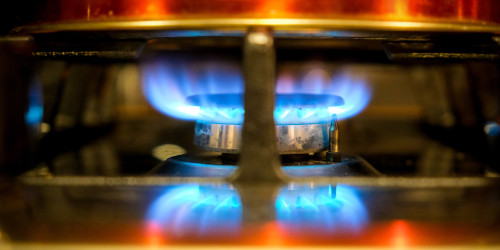Alternatives to gas heating are in demand like never before. But which variants are there and how can modernization be financed? An introduction to heat pumps, pellet stoves, solar thermal energy.
The price of gas goes up and up. Compared to July 2021, it has even more than doubled. For many Germans, this means turning down the heating. Or switch off completely. That may still be possible – but things look different in winter. Anyone who wants to save and not freeze at the same time is now looking at alternatives to gas heating.
advertisement
Heat pump, pellet stove, solar thermal energy: finance modernization with a loan
What are the alternatives to gas heating?
Germany is currently in the middle of a gas crisis. Looking at the development of gas prices is scary. And if you ignore the financial side, you have to worry when dealing with the general German gas situation. Either way, saving gas has never been as important as it is now. And it is possible: through the use of gas heating alternatives.
In addition to heat pumps (geothermal or environmental thermal energy), renewable energies for heating also include solar thermal energy, wood (e.g. pellet heating systems or stoves), biogas/biomethane and other biomass, as reported by the Federal Statistical Office. Conventional energy sources include oil, gas and electricity. Experts assume that the Russian war of aggression against Ukraine and the sanctions against Russia will make energy prices significantly higher.
Gas heating alternative: heat pump heating and heat pump
An attractive heating method is the heat pump. It extracts heat from the environment, which causes the refrigerant to evaporate in a heat exchanger. The heated refrigerant in turn ensures that the heating water is heated – then the process starts all over again. An ecologically attractive heating circuit is created.
The heat pump is particularly recommended in rooms that are sufficiently warm from a maximum flow temperature of 50 degrees Celsius. If these conditions are met, the heat pump is one of the most attractive alternatives to gas heating. If you also want to heat CO2-free, choose an electricity provider that relies entirely on renewable energies.
Converting to a heat pump requires comparatively little effort. But beware: Many Germans are currently looking for an alternative to gas heating and are having them replaced with a heat pump. The craftsmen with the appropriate expertise are heavily booked. So look around for skilled workers in good time before the cold season.
Heating alternative to gas: wood pellet stove
More and more people are discovering the pleasant warmth of a fireplace. A real alternative and very convenient to use is the wood pellet stove. Such a device can be used to heat individual rooms or – depending on the output – entire apartments.
If you want to heat with a pellet stove as an alternative to gas, you need wood pellets. Ideally, consumers buy these in spring or summer – then the prices for the pellets are comparatively cheap. A room is then required in which the pellets can be stored dry and safe until they are used.
In the past, switching to a pellet stove was only worthwhile if the gas heating system was getting on in years. With the current increase in gas prices, investing in a wood pellet stove pays off much earlier. Note, however, the price development of wood pellets.
Alternative to gas heating: solar thermal / solar energy
Solar energy is currently on everyone’s lips. Due to corresponding federal funding programs, more and more private households are also relying on the alternative energy source. There can be up to 45 percent state funding. With the rising gas price and the unforeseeable further development of the situation, the demand for corresponding solar modules is increasing significantly. The consumer center also advises consumers to rely on alternative energy sources such as solar thermal energy.
If you rely on a thermal solar system, you take advantage of the conversion of solar radiation into heat. Solar energy is converted into thermal energy, which in turn is used to produce hot water. Appropriate solar modules are attached to the roof of the house for this process. A well thought-out and established technology that is only financially worthwhile for households with more than four people. The technology is completely emission-free and low-maintenance. For families, solar energy is definitely an attractive alternative to gas heating.
But unfortunately there is a catch: With a modern solar system, consumers do not become completely independent of gas. The energy generated is usually not sufficient for gas-independent heating. Solar thermal energy can only provide sufficient heat in combination with gas heating. At least the gas consumption is reduced.
Switch to alternatives to gas now
The cold season is approaching – and the craftsmen have a lot to do. Anyone who wants to switch to ecological and more economical alternatives to gas should act now. So you are well prepared for autumn and winter and can put an alternative to gas heating directly into operation if necessary.
Important: Not only the alternatives to gas heating bring significant savings. It is also worth optimizing the energy in your home. In this way, alternative energy sources run more efficiently – and you save money, even if no alternatives to gas heating are in use.
Heat pumps are overtaking gas heaters
Heat pumps were used for the first time in more than half of new residential buildings in 2021 as the primary heating energy source. From 2020 to 2021 alone, the share rose by almost five percentage points from 45.8 percent to 50.6 percent. In 2015, the proportion was still 31.4 percent. Heat pumps are mainly used in detached and semi-detached houses: A heat pump was installed in 53.9 percent of all detached and semi-detached houses completed in 2021, the proportion in multi-family houses (30.6 percent) was significantly less frequent, with 21.4 percent having District heating and 39.1 percent heated with natural gas. The other renewable energies taken together are used as the primary heating energy source in 4.5 percent of all new residential buildings.
Gas heaters are being used less and less: In 2020, they were used as primary heating in 34.3 percent of new buildings – in 2015 the proportion was still 51.5 percent. Overall, the share of renewable energies as a source of heating energy increased from 61.5 percent to 70.7 percent between 2015 and 2021.
Heat pump heating instead of gas heating
As the second most important primary energy source, the conventional energy source natural gas was used in 34.3 percent of the new buildings. The share of gas heating as the primary energy source has decreased continuously in recent years. In 2020 it was still 39.0 percent and in 2015 it was 51.5 percent. 8.0 percent of the new residential buildings were primarily heated with district heating (2015: 7.8 percent). Oil heaters were only used as primary heating in 611 new residential buildings, which was only 0.6 percent of new buildings (2015: 1,195 or 1.1 percent).
If another (secondary) energy source was used in new residential buildings, the preferred renewable energy sources were solar thermal (13.1 percent) and wood (11.8 percent).
–


